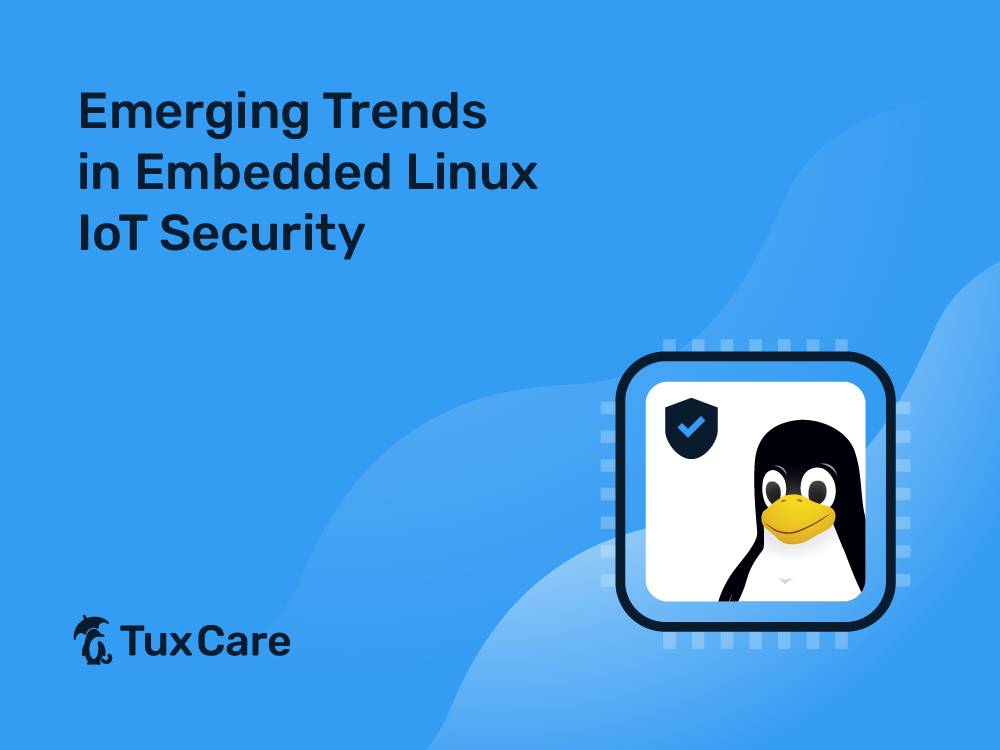Emerging Trends in Embedded Linux IoT Security
- Mitigating potential vulnerabilities requires proactive measures due to the complexity of embedded Linux IoT devices
- The use of containerization and virtualization reduces the attack surface and minimizes the impact of security breaches
- KernelCare IoT automates security patching for Linux-based IoT devices without taking them out of production to restart them
Embedded Linux systems play a pivotal role in powering a wide array of devices, from smart home gadgets to industrial machinery. Numerous applications, such as Internet of Things (IoT) devices, industrial control systems, automotive systems, medical equipment, and more, use these embedded systems. As IoT devices become increasingly prevalent, securing connected devices is a critical challenge. In this article, we’ll look at the latest trends in embedded Linux IoT security and how they are shaping the future of cybersecurity.
Growing Importance of Embedded Linux IoT Security
Embedded Linux security refers to the measures and practices used to safeguard devices running Linux-based operating systems that are embedded within various hardware platforms. As Linux is becoming more common in embedded devices, it is critical to make sure that robust security measures are implemented. Although Linux provides a solid foundation, mitigating potential vulnerabilities requires proactive measures due to the complexity of interconnected devices.
Some key aspects of embedded Linux IoT security include:
Access Control: Managing access to system resources, such as files, networks, and devices, through user permissions, authentication mechanisms, and encryption.
Secure Boot: Ensuring the integrity of the boot process to prevent unauthorized or malicious applications from loading when the system first boots up.
Hardening: Implementing security practices to reduce the attack surface and strengthen the system against various threats, including disabling unnecessary services, using firewalls, and applying patches.
Secure Communication: Utilizing VPNs, secure APIs, and protocols like TLS/SSL to secure communication channels between embedded devices and external systems.
Software Updates: Creating schedules for secure and timely software updates to fix vulnerabilities and improve system security.
Monitoring and Logging: Implementing monitoring tools and logging mechanisms to detect and respond to security incidents, including intrusion detection systems and audit trails.
Trends in Embedded Linux IoT Security
AI and Machine Learning for Threat Detection
As we explore the latest developments in embedded Linux security, it is impossible to overlook how revolutionary AI and machine learning applications can be. The adoption of AI and machine learning in embedded Linux IoT security solutions is one of the most noteworthy advancements.
AI-powered solutions go beyond known threats, identifying suspicious activities and potential weaknesses before they can be taken advantage of. By allowing systems to learn from patterns and anomalies, these technologies offer a dynamic defense against evolving cyber threats. This reduces the possibility of security breaches by enabling systems to quickly detect potential threats and take appropriate action.
Live Patching
Gone are the days of restarting devices to complete the patching process. The conventional patching method would often involve restarting IoT devices, leading to downtime and service disruptions. But that’s not the case with the KernelCare IoT live patching solution. With KernelCare IoT, you can apply all security updates and patches without taking IoT devices out of production to restart them.
Discover more about live patching IoT devices with TuxCare.
Containerization and Virtualization
The use of containerization and virtualization technologies in embedded Linux IoT environments enhances security by isolating applications and services. Containers provide lightweight, portable environments that encapsulate applications along with their dependencies, reducing the attack surface and minimizing the impact of security breaches.
Continuous Security Monitoring
The conventional model of security audits is evolving into a continuous monitoring strategy. Real-time analysis of system activity is made possible by AI and machine learning, adding another layer of defense against emerging threats. The transition to continuous security monitoring is essential for maintaining the integrity of embedded Linux systems.
Automated Patch Management
Imagine a scenario where security patches are deployed automatically. That’s the power of automation in patching. KernelCare IoT offers automated vulnerability patching for Linux-based IoT ecosystems. All security updates are applied immediately, minimizing the window of exposure to known vulnerabilities and increasing overall resilience against cyber threats.
Final Thoughts
Embedded Linux IoT security is rapidly evolving in response to the constantly changing cyber threat landscape. Keeping up with the latest advancements is crucial to ensuring a safe and resilient future of embedded Linux security. AI-driven threat detection, increased isolation, automation, and live patching promise to make it difficult for attackers to exploit vulnerabilities and gain access to critical systems. Enterprises can strengthen their embedded Linux ecosystems against cyber threats by considering these emerging trends and adopting proactive security measures.



 Documentation
Documentation Login
Login




